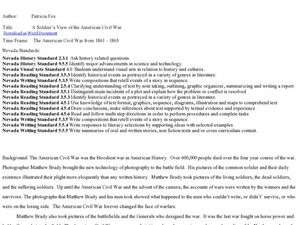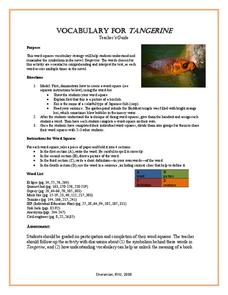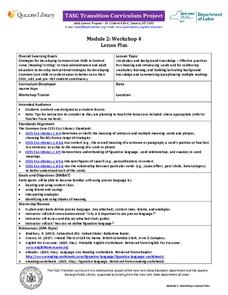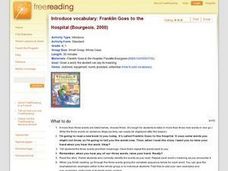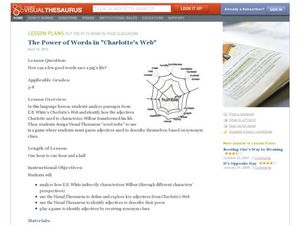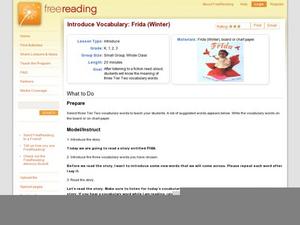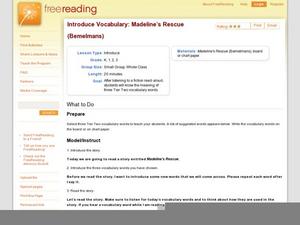Curated OER
Using Initial Sounds and Picture Clues to Read Unknown Words
Kindergarteners read the bold words that are unknown by using the strategies of initial sound and picture clues. They meet individually with their teacher in order to assess this concept. Excellent resource!
Curated OER
A Soldier's View of the American Civil War
Study and research the American Civil War in this explanatory writing instructional activity. Middle schoolers complete six activities to learn about the American Civil War and soldiers' views of the war. The instructional activity...
Curated OER
Applying Decoding, Vocabulary, and During Reading Strategies
Apply reading strategies to boost phonemic awareness. While reading a provided informational text, learners use decoding, vocabulary, and a graphic organizer to strengthen their overall reading ability. Handouts and the reading passage...
EngageNY
Identifying Author’s Opinion and Evidence: The Value of Sports in People’s Lives, Part II
Context matters! Using the intuitive resource, pupils decipher context clues to determine the meaning of unknown words from an informational text. Also, in small groups, they practice identifying the author's opinion and supporting...
Curated OER
Tangerine: Vocabulary
Here's a great way to make vocabulary words drawn from Edward Bloor's novel Tangerine memorable. Kids create a word square, and in one quadrant write the word. A picture goes in a second quadrant, the definition in a third, and a...
New York State Education Department
TASC Transition Curriculum: Workshop 4
Why is it important to use precise language? Participants explore this question in the fourth activity in a series of 15 on effective instruction. Perfect for all content areas, the activity promotes appropriate language choice through...
Curated OER
Knowledge Rating Scale Vocabulary Activity #2 Bud, Not Buddy
As your kids read chapters nine through eleven, present them with this vocabulary chart. Nine vocabulary words are shown, and pupils must decide if they know it well, have heard it, or have no clue what it means. Consider re-creating...
Curated OER
What Do You See at the Pond?
With What Do You See at the Pond?, young readers explore pond life and practice reading strategies. Learners first make predictions and then read the simple story independently. After a second read-through with a partner, kids come...
Curated OER
Introduce Vocabulary: Franklin Goes to the Hospital
Students read the book "Franklin Goes to the Hospital" and are introduced to 3 tier two words. In this reading comprehension lesson plan, students listen to the usage of the key words in the story. Students then answer questions...
Curated OER
Context Clues Lesson Plan
Students are introduced to four strategies of context clues. While reading, they use all four strategies in different sections of the reading to determine the meaning of words they are unfamiliar with. To end the lesson, they share new...
Curated OER
My Reading Words in My Social Studies Book?
Connect social studies and language arts using this resource. After studying root words, have learners locate five words from their social studies book that have a prefix, suffix, or root word. This puts a new twist on practicing basic...
Curated OER
The Power of Words in Charlotte's Web
"How can a few good words save a pig's life?" Posed with this question, your ELD students explore E.B. White's Charlotte's Web in a meaningful, valuable way. By analyzing specific word choice from the book, especially the excerpts...
Curated OER
Webbing Context Clues
Fifth graders explore strategies for identifying the meaning of unfamiliar words. In this vocabulary lesson, 5th graders apply a think aloud strategy for unfamiliar words. Students use context clues to identify unfamiliar words and write...
Curated OER
Introduce Vocabulary: Amigo (Baylor)
Amigo by Byrd Baylor gives learners a chance to practice with unknown words and context clues. Choose several vocabulary words to focus on as you read the picture book, or use the ones provided here (the book is in English...
Curated OER
Introduce Vocabulary: Frida (Winter)
Combine vocabulary in context with art history using Jonah Winter's colorful biography Frida. Although there are quite a few words you could teach from this text, four are listed here with connecting questions: ill, imitate,...
Curated OER
Introduce Vocabulary: Doctor DeSoto (Steig)
William Steig's story of a witty mouse couple will have scholars intrigued as they listen for new vocabulary words and context clues. Doctor DeSoto can be found on YouTube in case you don't have it. Emerging readers expand...
Curated OER
Introduce Vocabulary: Madeline's Rescue (Behelmans)
What new adventure is Madeline on now? Emerging readers expand their vocabulary in Ludwig Behelmans' story Madeline's Rescue. Although there are many words you could focus on here, five have been furnished with comprehension...
Curated OER
Exploring Arizona's Biotic Communities Lesson 2: Biotic Communities Vocabulary
Part of a unit on Arizona's biotic communities, this instructional activity focuses on the vocabulary to be used. Terms include biodiversity, topography, desert, hybridization, niche, and more! Youngsters will define these words from...
Curated OER
Winter Vocabulary
Looking for a winter-themed vocabulary activity? Provide each learner with several templates of a snowflake (you need to provide this), and have them write one vocabulary word on the middle of each snowflake. Then, after doing some...
K20 LEARN
Things Are Lit at Thornfield: Jane Eyre
Jane Eyre offers scholars an opportunity to practice reading comprehension skills. Pairs are assigned a word from the text, use their prior knowledge, and consider the context, connotation, and denotation of the word to posit a...
Curated OER
Lesson 1: Determine the Meaning of Unknown Words
Sixth graders use context clues to find the meaning of new vocabulary. In this vocabulary lesson, 6th graders read A Wrinkle in Time written by Madeleine L’Engle and use post its to flag words they don't know. They figure out the meaning...
Curated OER
Decoding Strategies
Students practice using context clues to decode the meanings of unfamiliar words. In this vocabulary skills lesson, students follow the provided instructions to complete graphic organizers that enable them to decode words in "The...
EngageNY
Relationships Between Key Scientific Concepts: Planning What Causes Earthquakes
That is ground shaking news! Scholars read Earthquake in multiple reads to determine the gist, identify cause and effect relationships, and understand vocabulary. Learners complete graphic organizers to describe what happens before and...
EngageNY
Using Quotes to Explain: Why Philo Farnsworth Invented Television
Television or radio? Scholars read pages 18-28 of The Boy Who Invented TV: The Story of Philo Farnsworth to discover why Farnsworth thought TV was better than radio. They determine the gist of the section and then look closer...

